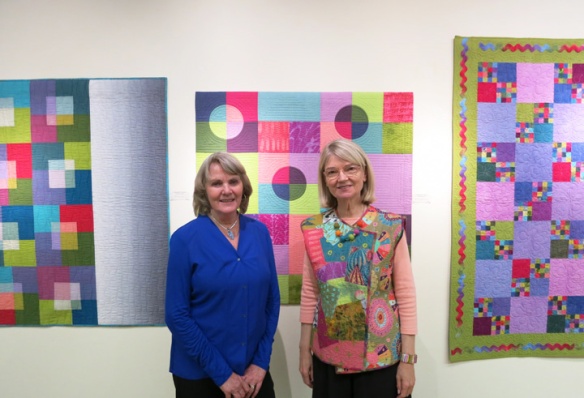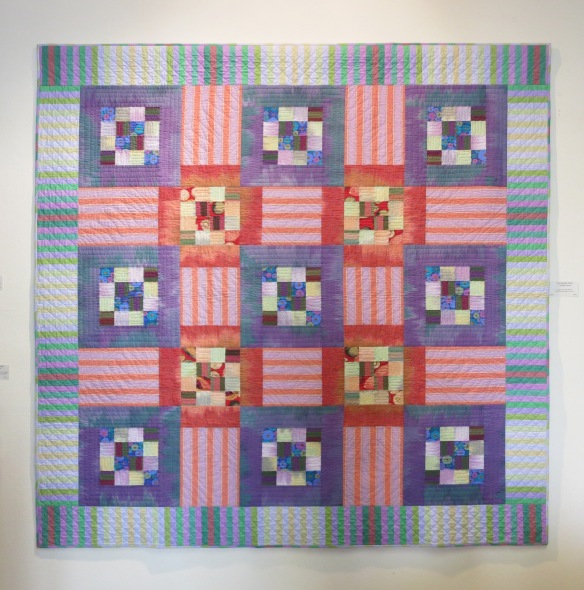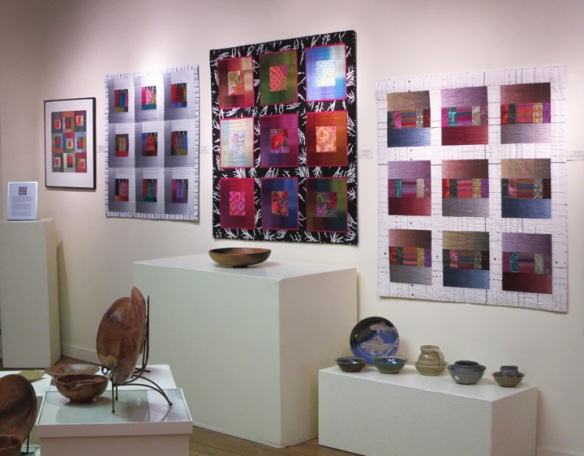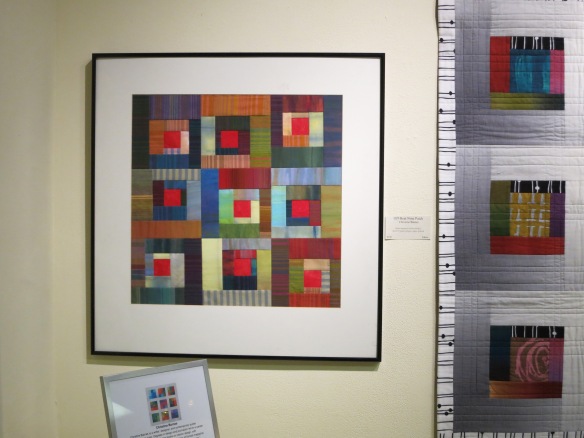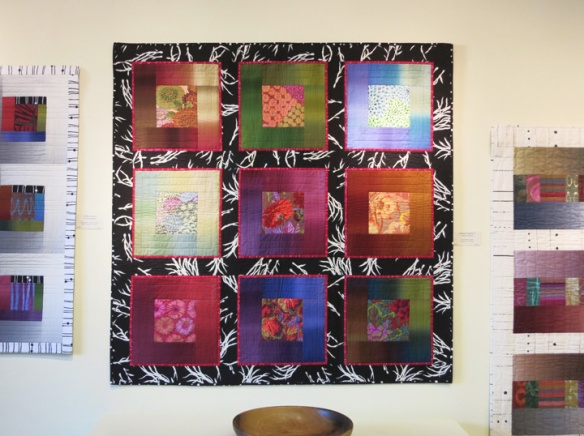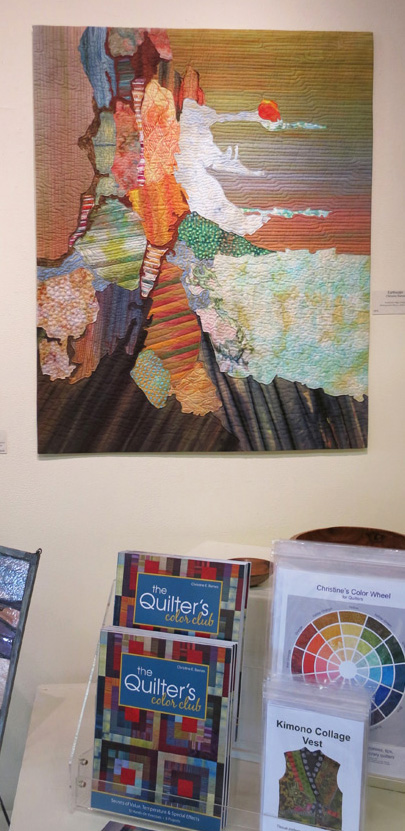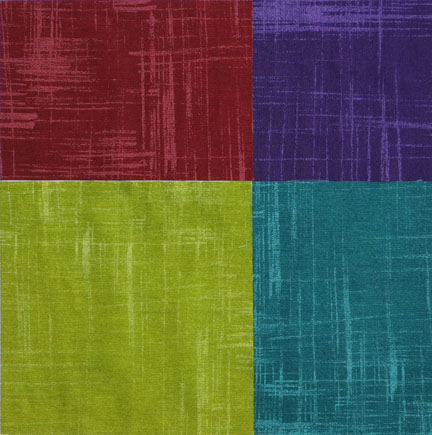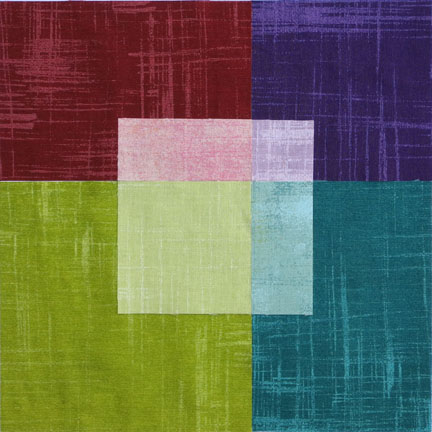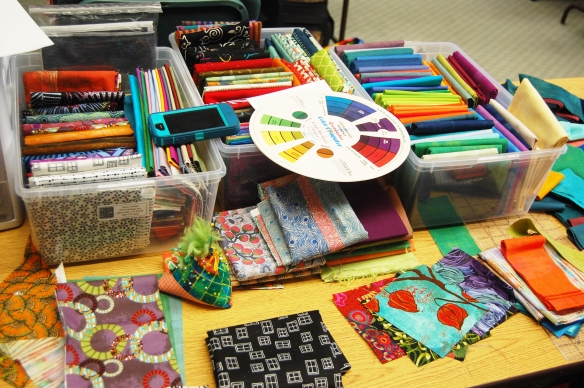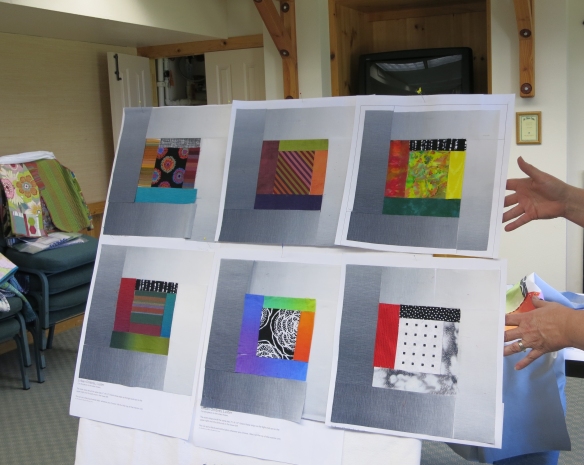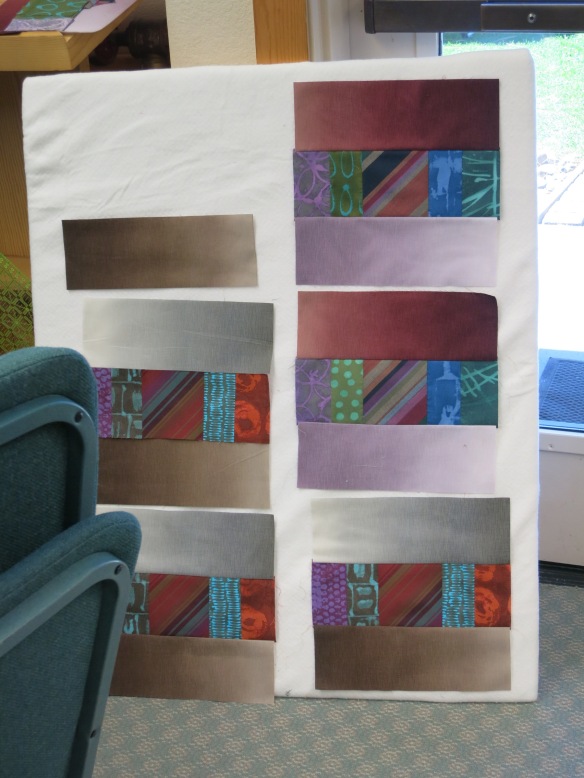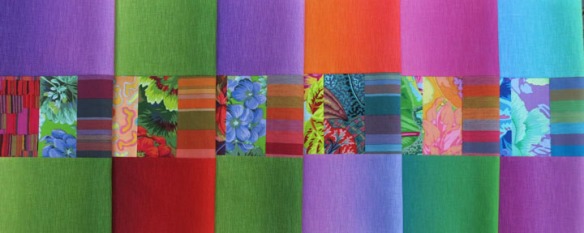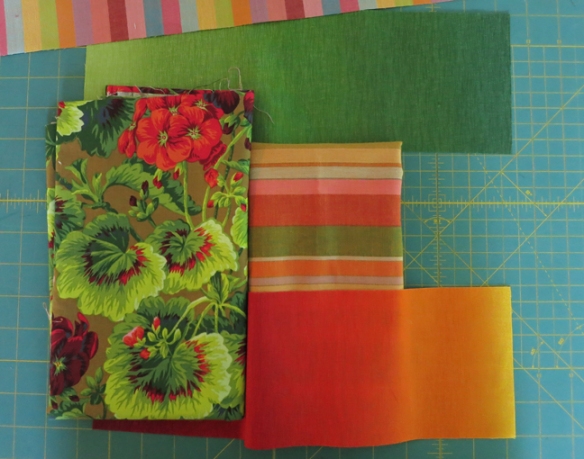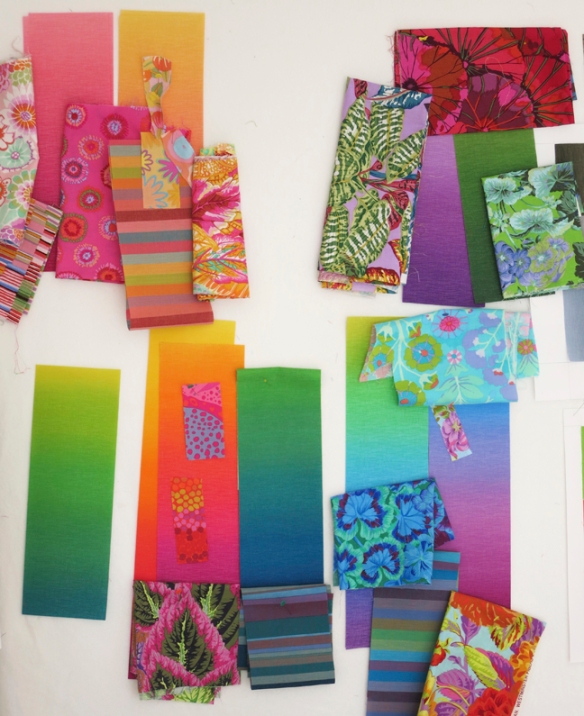by Christine Barnes
Well, fellow quilters, sewists, wearable artists, and others, here I sit, your Alchemist Emeritus, trying to decide what to say in my final post. You’ve heard about my plans for online classes, and you know you can keep up with me through my “Color Connection” newsletter. So I thought I’d talk about pattern in fabric. A student in a recent workshop said as she was leaving, “I learned as much about pattern as color today.” Great point. It’s hard to separate the two—they just go together.
Patterns are described by their style (naturalistic, stylized, abstract, geometric, ditzy, etc.), their scale (large, medium, small, and everything in between), and their density (open or closely spaced motifs). Classic design tells us to “vary the style and scale” of patterns in a design, such as a quilt, but when I mentioned this in a class early in my teaching career, one of the students tentatively raised her hand and said, “I have no idea what you mean by that.” I got the point and stuck with examples because visuals are almost always better than words, right? Right!
So let me show you pattern combinations in a few of my blocks and those of my students. In October I taught my “Urban Sunsets” quilt workshop for the Diablo Valley Quilters (what a great group!). Here are two blocks, one from my quilt, the other made after the quilt was finished. In the first example, the hand-painted fabric on the left is very open, the stripe is geometric and dense, and the Marica Derse print is stylized. (As an example, the paisley motif, which originated in India, is a stylized version of a pine cone.) In the block below, the scale of the hand-dye and the batik is very different, while the “pattern” of the red-orange Grunge is more like a texture.
In the block below, the scale of the hand-dye and the batik is very different, while the “pattern” of the red-orange Grunge is more like a texture. Back to the class . . . . In the delightful example below, you see a near-solid blue, a casual batik plaid, and a stylized floral. There’s a color connection among the fabrics, but the style, scale, and density are very different. Black-and-white strips help to separate the fabrics.
Back to the class . . . . In the delightful example below, you see a near-solid blue, a casual batik plaid, and a stylized floral. There’s a color connection among the fabrics, but the style, scale, and density are very different. Black-and-white strips help to separate the fabrics. What fun to see the repetition of dots in different sizes and colors. (This student was experimenting with the width of the skinny strips. I like to cut mine 3/4″ wide so they finish to a scant 1/4″.)
What fun to see the repetition of dots in different sizes and colors. (This student was experimenting with the width of the skinny strips. I like to cut mine 3/4″ wide so they finish to a scant 1/4″.) I couldn’t resist: Nancy, who once belonged to the Grass Valley guild, is technicolor 24/7. She definitely brightened my day.
I couldn’t resist: Nancy, who once belonged to the Grass Valley guild, is technicolor 24/7. She definitely brightened my day. Pressing the seams flat is essential to getting a crisp block.
Pressing the seams flat is essential to getting a crisp block. Don’t the center units look great up on the design wall? Yellow-green Grunge dots were popular that day.
Don’t the center units look great up on the design wall? Yellow-green Grunge dots were popular that day. A lovely block, with related colors and very different patterns. The variation in the scale of the prints is very sophisticated. A Grunge in the center ties the fabrics together.
A lovely block, with related colors and very different patterns. The variation in the scale of the prints is very sophisticated. A Grunge in the center ties the fabrics together.
Next stop, the Sacramento chapter of the Modern Quilt Guild, a very enthusiastic group of risk-takers. 🙂 The goal in this Granny block exercise was to work with a classic color combination. This block is a triad of red-orange, yellow-green, and blue-violet, three colors spaced equally around the color wheel. The patterns are busy, but the colors and values vary enough to keep the design sharp. This block is roughly the same color combination, but two of the fabrics are much less intense than the yellow-green. And wow, aren’t these patterns dynamic together? I especially like the way this student oriented the “striped” fabrics to draw the eye inward. Extra credit for this mock-block! (Not everyone filled in with background triangles on their mock blocks. We were having too much fun, with too little time.)
This block is roughly the same color combination, but two of the fabrics are much less intense than the yellow-green. And wow, aren’t these patterns dynamic together? I especially like the way this student oriented the “striped” fabrics to draw the eye inward. Extra credit for this mock-block! (Not everyone filled in with background triangles on their mock blocks. We were having too much fun, with too little time.) The Farmer’s Wife block, also known as Genny and Ruth, is a wonderful template for working with value, color, and pattern. Search Pinterest and you’ll see many versions—it’s such a versatile design. Here, black-and-white squares really bring the corners forward. Again, not everyone completed the background.
The Farmer’s Wife block, also known as Genny and Ruth, is a wonderful template for working with value, color, and pattern. Search Pinterest and you’ll see many versions—it’s such a versatile design. Here, black-and-white squares really bring the corners forward. Again, not everyone completed the background. Oh gosh, look what happens when the “star points” are white and part of the negative space is patterned—hard to believe it’s the same block as the previous one.
Oh gosh, look what happens when the “star points” are white and part of the negative space is patterned—hard to believe it’s the same block as the previous one.  I love the fresh colors and patterns in this block. Notice that the triangles are two different colors (yellow-green and blue). Great use of the airy, open print in the nine-patch unit, and the black-and-white print is the perfect scale for the corner squares. Nice!
I love the fresh colors and patterns in this block. Notice that the triangles are two different colors (yellow-green and blue). Great use of the airy, open print in the nine-patch unit, and the black-and-white print is the perfect scale for the corner squares. Nice! Finally, look what happens when the triangles in a “Japanese X and +” block are highly patterned and darker in value. This student gets even more extra credit for unique pattern placement—this block is going in circles, in a good way.
Finally, look what happens when the triangles in a “Japanese X and +” block are highly patterned and darker in value. This student gets even more extra credit for unique pattern placement—this block is going in circles, in a good way. In case I’ve left you confused, this is what a typical X and + block looks like, with the triangles as background.
In case I’ve left you confused, this is what a typical X and + block looks like, with the triangles as background. I hope those blocks inspire you to look at and work with color and pattern in new ways. A big thank you to my brave and cheerful and willing students!
I hope those blocks inspire you to look at and work with color and pattern in new ways. A big thank you to my brave and cheerful and willing students!
Let’s move on to my Studio Sale and the fabrics I love, but may never get around to using. Here’s how it works: Email me through the “Bio/Contact Me” page on my website, www.christinebarnes.com, not through our AA blog, and let me know what you want. I’ll add the sales tax and postage and get back to you with the total. If it’s agreeable, I’ll send you a Request for Money through Pay Pal. (You don’t need a PayPal account for this transaction.) Once you pay, I’ll send your package. You can also pay by check (I’ll give you my mailing address once we’ve agreed on the sale). OK, here goes . . .
1. This woven and hand-screened piece is from Kasuri Dyeworks, a famous high-end Japanese fabric store in the SF area. The shop closed more than a decade ago because, get this, artisans in Japan weren’t making many of these fabrics anymore; there just wasn’t the demand. (Google Kasuri Dyeworks to read the story.) So this is truly a gem. 40″ x 14¾”, $30 + tax and postage
 2. I bought this piece of hemp (yes, hemp) from a vendor selling Asian fabrics at Pacific International Quilt Festival. It’s very crudely woven, and has “unique” flaws, but I still LOVE the design. I tested a small corner of it in cold water and it barely bled. The true color is slightly lighter; for some reason my camera insisted on making it a bit darker. 45″ x 14″, $20 + tax and postage. The scissors in the bottom right are for scale.
2. I bought this piece of hemp (yes, hemp) from a vendor selling Asian fabrics at Pacific International Quilt Festival. It’s very crudely woven, and has “unique” flaws, but I still LOVE the design. I tested a small corner of it in cold water and it barely bled. The true color is slightly lighter; for some reason my camera insisted on making it a bit darker. 45″ x 14″, $20 + tax and postage. The scissors in the bottom right are for scale.
 3. This yukata cloth came from Kitty Pippen, an author and internationally known quilter of Japanese fabrics, and a lovely lady. It would make a gorgeous wall hanging, framed by other sophisticated fabrics. 36″ x 14¾”, $20 + tax and postage
3. This yukata cloth came from Kitty Pippen, an author and internationally known quilter of Japanese fabrics, and a lovely lady. It would make a gorgeous wall hanging, framed by other sophisticated fabrics. 36″ x 14¾”, $20 + tax and postage
 4. Alexander Henry “kyugetsu dolls,” no longer available. The colors are exquisite and the black is deep and rich. 1 yard + 2 inches, $17 + tax and postage
4. Alexander Henry “kyugetsu dolls,” no longer available. The colors are exquisite and the black is deep and rich. 1 yard + 2 inches, $17 + tax and postage The next two photos were taken on either side of the fold:
The next two photos were taken on either side of the fold:
 5. A Robert Kaufman print, as it would appear on a bolt. 1 yd. $12 + tax and postage
5. A Robert Kaufman print, as it would appear on a bolt. 1 yd. $12 + tax and postage 6. A batik of many wonderful colors. 1 2/3 yds. $20 + tax and postage
6. A batik of many wonderful colors. 1 2/3 yds. $20 + tax and postage
 7. I’ve always been drawn to ethereal batiks in organic geometric patterns. 1 yard, $12 + tax and postage
7. I’ve always been drawn to ethereal batiks in organic geometric patterns. 1 yard, $12 + tax and postage
 8. More hard-to-say-goodbye-to fabrics, indigo batiks from a primitive-fabric vendor at the Marin Needle Arts show. 6 fat quarters, $16 + tax and postage
8. More hard-to-say-goodbye-to fabrics, indigo batiks from a primitive-fabric vendor at the Marin Needle Arts show. 6 fat quarters, $16 + tax and postage 9. The center square in the piece below is Kaffe Fassett, the ombré is by Caryl Bryer Fallert (no longer available), and the stripe is also by Kaffe. This block photographs as very rich and saturated, but it’s a bit more muted in real life. 17″ x 17″, $18 + tax and postage
9. The center square in the piece below is Kaffe Fassett, the ombré is by Caryl Bryer Fallert (no longer available), and the stripe is also by Kaffe. This block photographs as very rich and saturated, but it’s a bit more muted in real life. 17″ x 17″, $18 + tax and postage 10. Finally, I made a series of these blocks in different fabrics, then matted, framed, and hung them together to make a “hard-edged Ninepatch.” I had a “recipe” to create a sense of depth and layering: a light batik center, surrounded by two darker fabrics, and finished with an even lighter batik. 12½” x 12½”, $14 + tax and postage
10. Finally, I made a series of these blocks in different fabrics, then matted, framed, and hung them together to make a “hard-edged Ninepatch.” I had a “recipe” to create a sense of depth and layering: a light batik center, surrounded by two darker fabrics, and finished with an even lighter batik. 12½” x 12½”, $14 + tax and postage  If you’re still with me, thank you so much for looking. Keep in mind that I’ll have periodic studio sales in my newsletter, “Christine’s Color Connection.”
If you’re still with me, thank you so much for looking. Keep in mind that I’ll have periodic studio sales in my newsletter, “Christine’s Color Connection.”
So as I end my role as an “active Alchemist,” let me say that it’s been a delight spending time with you. I’ll be following the blog along with all of you, enjoying every bit of creativity and inspiration that Heidi, Mary, Sandra, and Jane share. Yay, AA!



















